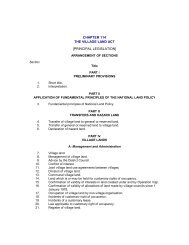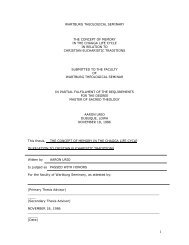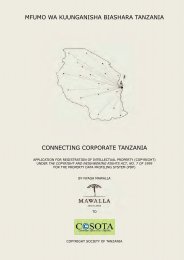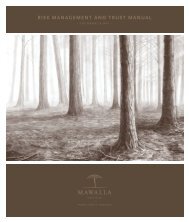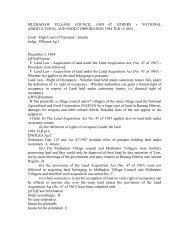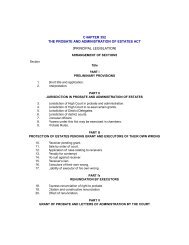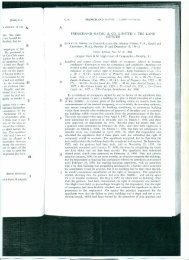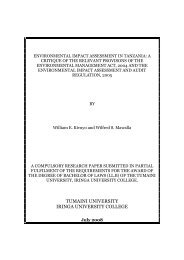METTHUSELAH PAUL NYAGWASWA v CHRISTOPHER MBOTE ...
METTHUSELAH PAUL NYAGWASWA v CHRISTOPHER MBOTE ...
METTHUSELAH PAUL NYAGWASWA v CHRISTOPHER MBOTE ...
You also want an ePaper? Increase the reach of your titles
YUMPU automatically turns print PDFs into web optimized ePapers that Google loves.
There was also a successful application by the respondent for an order for additionalevidence to be taken. This Court took such additional evidence from Fidelis Kilulumo, aH Senior Co-operative Officer in the City Co-operative Office of the City Council of Dares Salaam.The following facts are not in dispute. The respondent applied for a plot of land to theCity Council of Dar es Salaam in early 1978 and he got an offer dated 18.7.78. Hefollowed up the offer and was duly issued with a certificate of Occupancy No. 22549 Iover Plot 130, Mbezi Beach,1985 TLR p106MUSTAFA JJA, MAKAME JJA, OMAR JJAfor a term of 99 years commencing from 1.7.1978. This was duly registered on 2nd ADecember, 1978. The Certificate of Title contained in its schedule a registered surveyplan showing the boundaries of Plot 130. The respondent obtained a building permitfrom the City Council of Dar es Salaam. However before the respondent could build theappellant entered the said plot claiming ownership and commenced to build thereon Bdespite objections from the respondent. The respondent obtained a temporary courtinjunction and eventually the appellant ceased erection. A part of the appellant's buildingstands on about 79 sq. metres of Plot 130.The appellant had purchased a piece of land for Shs.11,000/= from one Vincent PatrickC on or about 1.4.78 in Mbezi Beach. That piece of land was unsurveyed and allegedlyincluded the land forming Plot 130. The appellant's title to the land consisted only of theinformal agreement to purchase from Patrick and nothing else. The said sale waswitnessed by the C.C.M. Branch Chairman at Kawe. The appellant was building the Dfoundation of his house when the suit against him was filed in the High Court, but nowthe house is semi-finished. He disputed that the land he had purchased was within theboundaries or jurisdiction of the City Council of Dar es Salaam.The additional witness Kilulumo has stated that Mbezi Village was in the Green belt Earea, and although within the jurisdiction of the City Council of Dar es Salaam, was arural as opposed to an urban area, and that the Village and Ujamaa Village Act of 1975,No. 21 of 1975, was designed to register such rural villages. He was of the decided viewthat Mbezi Beach was within the jurisdiction of the City Council of Dar es Salaam F andformed part of Mbezi Village which was registered as a village under 1975 Villages andUjamaa Villages Act on 25.2.1976 and was incorporated on 1.12.76.The trial judge found that the Mbezi Beach area on which the disputed Plot No. 130 issituated was declared to be planning area by the Ministry of Lands under the provisionsG of section 13 of the Town and Country Planning Ordinance Cap. 378. He referred toG.N. 171 of 1966 which declared Mbezi, among other areas, to be a planning area, and heheld that a survey plan of the said area was made by the Ministry of Lands. I think Prof.Fimbo who appeared for the appellant before us was attempting to question the Hlocation of Plot 130. On a review of the evidence I am satisfied that Mbezi Beach iswithin the jurisdiction of the City Council of Dar es Salaam and is a planning area. I amalso satisfied that Plot 130 is situated at Mbezi Beach, which forms part of Mbezi villageand that this was the land in dispute between the parties.The trial judge appeared to have held that once an area has been declared to be a Iplanning area, customary law concerning land holding
is extinguished and he thereby becomes a "squatter" on an area being declared a planningarea.Prof. Fimbo submitted that in the High Court, the suit had proceeded on the basis that CPlot 130 was in an urban area, Mr. Kilulumo has testified that Plot 130 was situated in theGreen belt, that is, a rural area. Prof. Fimbo contended that this piece of evidence byKilulumo has brought in a new element in the case, and cannot be accepted orentertained. If I understood Prof. Fimbo correctly he was submitting that if plot 130 wasD in an urban area then the provisions of the Town and Country Planning OrdinanceCap. 378 would apply and that in the circumstances, Act 21 of 1975, the Villages andUjamaa Villages Act 21 of 1975 would not be applicable. Prof. Fimbo contended thatthere was an inconsistency and indeed a conflict between the provisions of section 35 ofE Cap. 378 and Direction 5 of G.N. 168/75 (Directions made under the provisions ofsection 23 (4) of Act 21 of 1975). Prof. Fimbo was of the view that no reference shouldbe made to the provisions of Act 21 of 1975 or to the directions made thereunder indeciding this appeal as Act 21 of 1975 was not at all applicable to the matter in dispute.In reply Mr. Mkatte has submitted that the suit was filed in respect of a registered pieceF of land in Dar es Salaam and the suit had to be tried in the High Court. That hadnothing to do with whether the plot was in an urban or rural area, as rural plots are alsoregisterable.I am not impressed by Prof. Fimbo's submission on this point. I see no conflict betweenG Section 35 of Cap. 378 and Direction of G.N. 168 of 1975. Section 35 of Cap. 378deals with the need of obtaining consent before developing any land within a planningarea, whereas Direction 5 of G.N. 168 of 1975 contains provisions for the obtaining ofapproval for the disposal of land etc. from the Village Council in respect of land of a Hregistered village. As I see it, if a registered village is within a planning area, thenconsent of the City Council to develop land has to be obtained. That in no way interfereswith the need to obtain the other necessary approvals from the Village Council. I do notsee why the provisions of Act 21 of 1975, or the directions made thereunder, if relevant,should not be looked at. IReference was made by both Prof. Fimbo and Mr. Mkatte to section1095 TLR p109MUSTAFA JJA, MAKAME JJA, OMAR JJA33 of the Land Registration Ordinance Cap. 334. Section 33 reads in part: A33 (1) The owner of any estate shall, except in the case of fraud, hold the samefree from all estates and interests whatsoever, other than -(b) (not applicable) B(c) The interest of any body in possession of the land whose interest isnot registerable under the provision of this Ordinance CIt is common ground that the respondent's certificate of occupancy was registered. Mr.Mkatte also contended that this was a first registration, without fraud. Mr. Mkattesubmitted that section 33 (1) (b) does not help the appellant. He alleged that there wasevidence from which it could be inferred that the appellant's estate in the disputed land Dwas registerable in terms of Cap. 334. The evidence, according to Mr. Mkatte, consistedin the value of the building, over Shs.500,000/=, being put up by the appellant, and in theview expressed by the appellant that he "wanted to own the place for as long as Iwanted...." Mr. Mkatte submitted that it would follow that the appellant was putting E
up a permanent and substantial building and was contemplating occupation for a term inexcess of 5 years and the land was thus registerable. On the other hand Prof. Fimbosubmitted that section 33 (1) (b) refers to "interest" in the land being registerable. Hecontended that the appellant's interest in the land which derived from native law andcustom was nowhere stated to be registerable under the provisions of Cap. 334. In any Fevent Prof. Fimbo denied that this was a first registration.I am of opinion that this was not a first registration. I am also of the view that the interestof the appellant was not compulsorily registerable, and by virtue of section 33 (1) (b) ofG Cap. 334 the right of the respondent vis-a-vis the appellant is not indefeasible andunimpeachable in the circumstances.Mr. Mkatte referred to the additional evidence adduced and to his further grounds foraffirming the Court's decision. He submitted that the sale or purported sale of the land byPatrick to the appellant was void and ineffective and the appellant had not acquired H anyinterest in or title to the land. The land is in Mbezi Beach and Mbezi Beach formed partof Mbezi village which was a registered village under the Village and Ujamaa VillagesAct No. 21 of 1975. By G.N. No. 168 of 1975 Directions were made under Act 21 of1975. Direction 5 (6) reads: I1985 TLR p110Except with the approval of the village council no person shall A(a) Transfer to any other person his right to the use of land in a village; or(b) Dispose of his house, whether by sale of otherwise.Mr. Mkatte submitted that there was no approval obtained from the Village Council for Bthe sale or transfer of the land to the appellant. The transfer was therefore void and nointerest could have passed from Patrick to the appellant.It is not disputed that the land was held under a right of occupancy, assuming that CPatrick was the rightful person in possession, under native law and custom. AlthoughPatrick had not indicated the extent of the land he had purported to sell to the appellant, Iwill assume for the purpose of this appeal, that the land included the area of Plot 130, orat any rate the portion of 79 sq. metres on Plot 130 on which a part of the appellant'sunfinished building stands. DIt is common ground that the President can issue a right of occupancy in terms of section6 of Cap. 113 to a person. However the disposition of a right of occupancy is subject tothe Land Regulations made under Cap. 113. Regulation 3 of the Land Regulations 1948(in Cap. 113 Supplement 64) reads: Ea disposition of a right of occupancy shall not be operative unless it is in writingand unless and until it is approved by the President.There is a long line of judicial decisions which established that a disposition of a right ofF occupancy without the necessary approval or consent was inoperative, unenforceableand void, see for instance Patel v Lawrenson & another [1957] E.A. 249, AlexanderPaterson & another v Kanji [1956] 23 E.A.C.A.106 and Fazal Kassam v A.N. G Kassam[1960] E.A. 1042. Regulation 3 of 1948 would apply to rights of occupancy issued andgranted under the provisions of Cap. 113.It appears that following the same principle rights to land held in a registered village canonly be transferred with the approval of the Village Council. And Mr. Mkatte submittedH that the sale by Patrick to the appellant, for lack of approval, was void and of no
effect. The appellant had not acquired any right or title to any land. There was thus noright to be extinguished.Prof. Fimbo submitted that the Directions issued under G.N. 168 of 1975 should be readin their context. He stated that the sub-directions of Direction 5 should be read Itogether. I will, for convenience, set out Direction 5 in full:1985 TLR p111MUSTAFA JJA, MAKAME JJA, OMAR JJA5 (1) Land for the use of a village shall comprise such areas of land as may beA reserved for the purpose and allocated to the village by the District DevelopmentCouncil.(2) Subject to availability of arable land, the village council shall allot a pieceof farmland to every kaya in the village according to need and ability to develop it. Thevillage council shall have power to determine the structural B pattern of farms in thevillage and the use thereof.(3) Subject to an availability of land every kaya shall be entitled to anallotment at least one acre of land for the purpose of building thereon dwelling housesand for other domestic purposes. C(4) Every piece of land allotted to a kaya for its use shall be subject to theoverall control of the village council.(5) The village council shall make provision for reserve land for futureexpansion of the village.(6) Except with the approval of the village council no person shall - D(a) transfer to any other person his right to the use of land in a village;(b) dispose of his house, whether by sale or otherwise.(7) In the exercise of its powers relating to planning and co-ordination of theactivities of residents of the village engaged in agricultural activities the Village ECouncil shall ensure that every piece of land allotted to a kaya for its use shall at all timesbe maintained as an economic unit and no fragmentation or other use of similar kind shallbe permitted. FProf. Fimbo contended that there was no evidence to indicate that Patrick had obtainedhis piece of land from the Village Council. Prof. Fimbo asserted that Direction 5, read aswhole, would give the Village Council control only over land it had allocated to the kayaor villagers. He called attention especially to 5(1) and 5 (4) in support of this Gcontention. He submitted that if a villager held land in a registered village which was notallocated to him by the Village Council, then such villager or his land is not subject to thecontrol of the Village Council. Indeed such land would not be subject to any controlwhatever. The provisions of Direction 5 (6) therefore would not apply in this case to thesale by Patrick to the appellant. HIn dealing with this point I have to consider the basic and root source from which all titleto land in Tanzania is derived. I refer to sections 3 and 4 of the Land Ordinance Cap.113. Section 3 (1) reads: I1985 TLR p112MUSTAFA JJA, MAKAME JJA, OMAR JJAThe whole of the lands of Tanganyika, whether occupied or unoccupied on thedate of the A commencement of this Ordinance are hereby declared to be public lands.
Section 4 of Cap. 113 declared all public lands to be under the control and subject to Bthe disposition of the President and that no title to the occupation and use of such landsshall be valid without the consent of the President.I have already dealt with the control of disposition of land held under a certificate of titlegranted by the President. In my view, in a registered village, all the land within it wouldC be similarly under the control of the Village Council and I do not read Direction 5 asonly dealing with land actually allocated to villagers by the Village Council. I thinkDirection 5 (6) means exactly what it says, that without the approval of the VillageCouncil, no person shall transfer his land. I cannot envisage that certain lands and Dcertain villagers living in a registered village would be exempt from its jurisdiction andcontrol. That would create an absurd situation. If there were exemptions, it was easy tohave said so in the directions.Prof. Fimbo also submitted that no approval of the Village Council was obtained for thegrant of the land in dispute to the respondent. True, but I think the directions in G.N. E168/75 are only concerned with the relationship between the Village Council and its kayaand villagers, and do not concern the superior landlord, an outside authority in the personof the President. However, should the respondent wish to transfer or dispose of his land,I would think he has to obtain two sets of approval, approval from the Village F Counciland approval in terms of Land Regulation 3.I am of the view that the sale by Patrick to the appellant of the land in Mbezi was voidand ineffectual as it took place without the approval of the Village Council. Theappellant had not acquired any right or title in the land which could defeat the title in theG land acquired by the respondent by virtue of the certificate of occupancy issued tohim. There was no extinguishing of the appellant's anterior title to the land; he never hadacquired a title to or interest in the land in dispute. Indeed the appellant may well thinkit advisable to take steps to regularise his occupation of the land he had allegedly Hpurchased from Patrick.I will now deal with the damages awarded to the respondent. The trial judge had referredto the difference in the estimated costs of the construction of the proposed building by therespondent for the periods 1978/79 and 1983. The difference amounted toShs.287,200/=. The delay in building was due to the act of the appellant. The trial Ijudge accepted the figure as reasonable.1985 TLR p113MUSTAFA JJA, MAKAME JJA, OMAR JJAProf. Fimbo submitted that there was no evidence that the respondent had taken Apossession of the plot and had purchased or was prepared to place building materialsthereon for erection purposes. There was only evidence adduced concerning the cost ofconstruction in the two periods; there was no evidence that the respondent was actuallyready willing and able to build in 1978/79. An approved building plan by itself does notB necessarily mean that the respondent was ready to proceed.I think that there is merit in Prof. Fimbo's submission. There should have been evidencethat the respondent was ready willing and able to proceed to build, but was preventedfrom doing so in 1978/79 by the appellant's action. I think a nominal sum should haveC been given for damages in the circumstances, as I am not satisfied that a sufficientfoundation had been laid for the amount claimed. I would reduce the damages awardedto a nominal sum of Shs.5,000/=.
The trial judge had ordered the demolition of that portion of the building which was builton a part of plot 130. He ordered the appellant to demolish the said portion and removeD the materials from plot 130 at his own expense by a certain date after which suchmaterial, if not removed, would become the respondent's property.I am satisfied that this is a reasonable order as the appellant had proceeded with theerection even when he knew that the respondent had applied for an injunction. It Eappeared to me that the appellant had wanted to confront the respondent with a faitaccompli. It was at rather a late stage that the appellant desisted from erection. Thestructure is completely useless to the respondent. The appellant has mostly himself toblame for the loss to him due to this order for demolition. FIn the result the appeal is dismissed, except that the award of damages in the sum ofShs.287,200/= in favour of the respondent is set aside and a sum of Shs.5,000/= issubstituted therefor. The order for costs in the High Court remains undisturbed. GAs for the costs of the appeal, since the appellant has succeeded on the item of damagesawarded, I would order each party to bear his own costs.As Omar, J.A. agrees, there shall be an order on the terms above stated.H Appeal dismissedMakame, J.A. (dissenting): I had the advantage of reading in draft the elaboratejudgment of my learned brother, Mustafa, J.A. I must confess that this appeal has causedme considerable anxiety. II have no doubt about the identity and location of the plot in dispute.1985 TLR p114MAKAME JAIt is Plot No. 130 and forms part of the parcel of land which the appellant got fromA D.W.2 Vincent Patrick Mmole on 1st April, 1978. It is the plot in Mbezi Village towhich Fidelis Paulo Kilulumo, who gave additional evidence before this Court, was takenby the respondent.When the respondent was made an offer of the parcel of land in dispute on 18th July,B 1978 the area had already been designated and registered as Mbezi Village, under theVillages and Ujamaa Villages Act, 1975. The spirit and effect of the Act, and the variousregulations made under it, is among other things, to place the land within the jurisdictionof the Village at the disposal of the village and its kayas, under theC administration of the village, for the economic and social transformation anddevelopment of the village and its inhabitants. The State decided that it should be so, andit would defeat the objective of the law if grants over the same land were made, even bysuperior authorities without consultation, or at the very least knowledge, of the villageauthorities.D This, I am satisfied, is what happened in the instant case, as is clearly brought out bythe testimony of D.W.3 Ally Kibwana, the C.C.M. Branch Chairman of the area and oneof the persons who witnessed the transactions between the appellant and Mmole. Thereis no evidence that at the time of the said transaction the area had already been Esurveyed, infact the Defence evidence is that it had not been. Once the appellant got theplot, in April, 1978, he contacted the Kinondoni District Land Office for a survey andtitle, and the same District Land Office turned round and made an offer to the respondentin July, 1978, behind the appellant's back as it were, when it knew that the F appellant
was in possession and wanted a title. According to Kilulumo "The Land Office wouldnot survey a piece of land and allocate it to somebody without involving the VillageCouncil".According to the evidence, Mole got the piece of land from the local authorities, wayG back in 1963. Mbezi Village found him already there therefore. His transfer of hiscustomary right over the land was witnessed and sanctioned by the village authoritiesincluding the Ward Secretary who affixed his official stamp on the document. There isalso an endorsement to the effect that the Party Office had no objection. One of thewitnesses to the transaction was D.W.3 the C.C.M. Chairman of the Branch in the HVillage. I am unable to agree with Prof. Fimbo that the Village Council was notnecessary in the case of the transaction involving his client. In my view all landtransactions in the village need village council approval. If I understood Mr. Mkatte forthe respondent, and I think I did, he submitted that such approval was necessary and wasnot obtained. As already indicated I go along with him on the first part - that I approvalwas necessary, but I do not share the view that the transaction was void1985 TLR p115MAKAME JAfor lack of such approval. I look at the realities of the situation. The Chairman agrees, Athe Ward Secretary says there is no objection, and the official stamps are affixed in thepresence of witnesses. Those authorities were acting on behalf of the village and I amsatisfied that the sale by Mmole, and the purchase by the appellant, were effective andgood in the circumstances. The transaction was regulated by the authorities and B thereis no evidence that the portion of land had at the material time already been alienatedfrom the village.I am of the view that the respondent's Right of Occupancy was issued in impropercircumstances and did nothing to disturb or extinguish the appellant's right.C I would allow the appeal with costs.Omar, J.A.: I have read both the judgment of Mustafa, J.A. and Makame J.A. on thiscase and I am convinced that the legal arguments in favour of the ownership of thedisputed piece of land by the respondent are more cogent than those advanced by theD appellant. It is not disputed that appellant bought this piece of disputed land (in whichplot 130 is also included) from Patrick but did these village functionaries who witnessedthe transaction act as Members of Village Council? There is evidence that they did nottherefore, there was no consent given. Consent is legal requirement whether it be given Eby the President of the United Republic or by the Village Council. We cannot say it wasnecessary but not fatal to the transaction when it was not obtained. And when the letterof the law is clear and unambiguous on any matter we do not look for its spirit.Appellant may have wanted to get a normal right of occupancy over the plot he "bought"F from Patrick and he sent his application to the land office much ahead of therespondent but his application was ignored or turned down and the respondent'sapplication was granted. A number of applications are sent to the Land Office; thosewhich are approved are of the successful applicants and can claim ownership overG surveyed areas; those applications which are not acted upon its owners cannot be heardto say that they were first in applying and, therefore, would go ahead with thedevelopment of the land that would really be naive on their part.
All in all I would uphold the Judgment of Mustafa, J.A. because the law on this subjecthas been exhaustively discussed by him and he has left no stone unturned in arriving at Hthe just decision affecting both parties.I Appeal dismissed




